“We need pace to find drugs for the hundreds of diseases we still have no treatment for. We need leadership responsibility to improve medicines accessibility and sustainability. And we need to build on the excitement around new modalities such as RNA, cell and gene therapies, and oligonucleotides to ensure we design the optimal manufacturing solutions to make them affordable.”
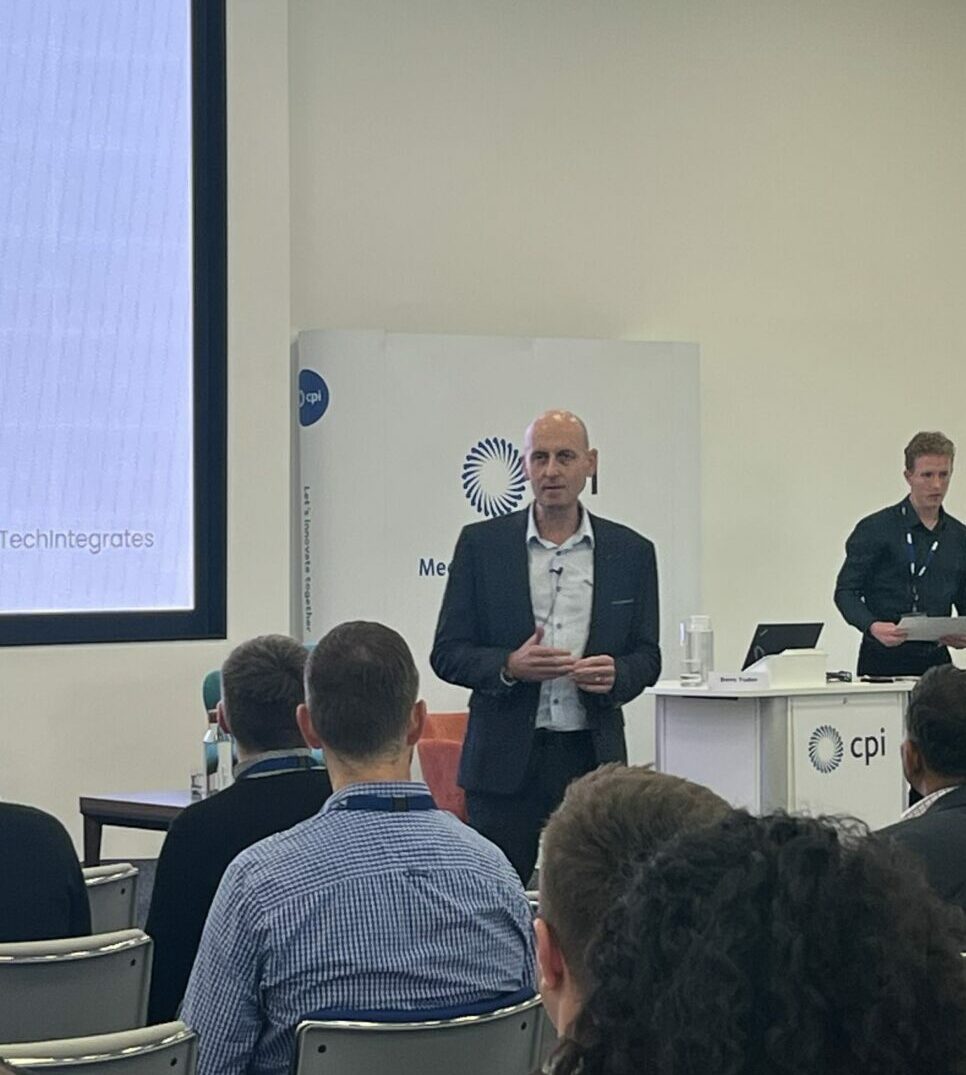
Dave Tudor
Managing Director, Medicines Manufacturing Innovation Centre, Biologics & Quality, CPI
Leaders from industry, academia, and governing bodies gathered in the heart of Glasgow’s Advanced Manufacturing Innovation District to discuss the future of medicines manufacturing at PharmaTech Integrates 2023. Life Science Integrates takes conferences to the coalface of innovative science, and PharmaTech Integrates took this to a new level, held across two state-of-the-art venues: the home of official event partner CPI’s Medicines Manufacturing Innovation Centre, and the newly opened National Manufacturing Institute Scotland. With a rich programme of interviews, panel sessions, facility tours, and networking, delegates discussed, debated, and saw first-hand the innovative technologies that are shaping the future of the PharmaTech sector.
Dave Tudor welcomed the speakers, sponsors, and the 300 online and in-person delegates with a message of thanks. “I asked my 80-year-old Dad, who’s recently suffered from cancer, what he’s like to say to this audience of pharmaceutical professionals. He said two things: ‘tell them they do brilliant work that’s changed my life, and say a huge thank you to them’.”
Dave gave conference attendees three words to keep in mind throughout the day: pace, responsibility, and excitement.
“We need pace to find drugs for the hundreds of diseases we still have no treatment for. We need leadership responsibility to improve medicines accessibility and sustainability. And we need to build on the excitement around new modalities such as RNA, cell and gene therapies, and oligonucleotides to ensure we design the optimal manufacturing solutions to make them affordable.”
Fireside Chat
Fireside Chat 1: Future Industry Challenges
– What are the future challenges facing the Pharma industry?
– What role will Digital Innovation play?
“We need to see that the juice is worth the squeeze”
– Fireside chat 1
“As we explore the future of the pharmaceutical industry, what are the challenges and opportunities, and how can digital innovations help us address these?” asked Maureen Wedderburn, addressing experts from industry, academia, and regulatory governance.
“The industry isn’t homogonous, but one challenge affects us all: how do we cope with the rate of innovation?” asked Ian McCubbin. From an academic perspective, David Littlejohn outlined the challenges accompanying lower concentration APIs and larger molecule modalities: “workforce up-skilling and training is essential to allow us to adopt the new manufacturing technologies to support these trends.”
Adding a regulatory perspective, Ian Rees spoke of capacity and international harmonisation. “Regulators need the capacity to engage with industry and patients to understand what’s required, and international alignment to support manufacture and supply across borders.”
All speakers agreed on the advantages of digital innovation in terms of productivity, pace, and patient benefits: “if we optimally utilise digital solutions, just think of the benefit we could bring to the patient.”
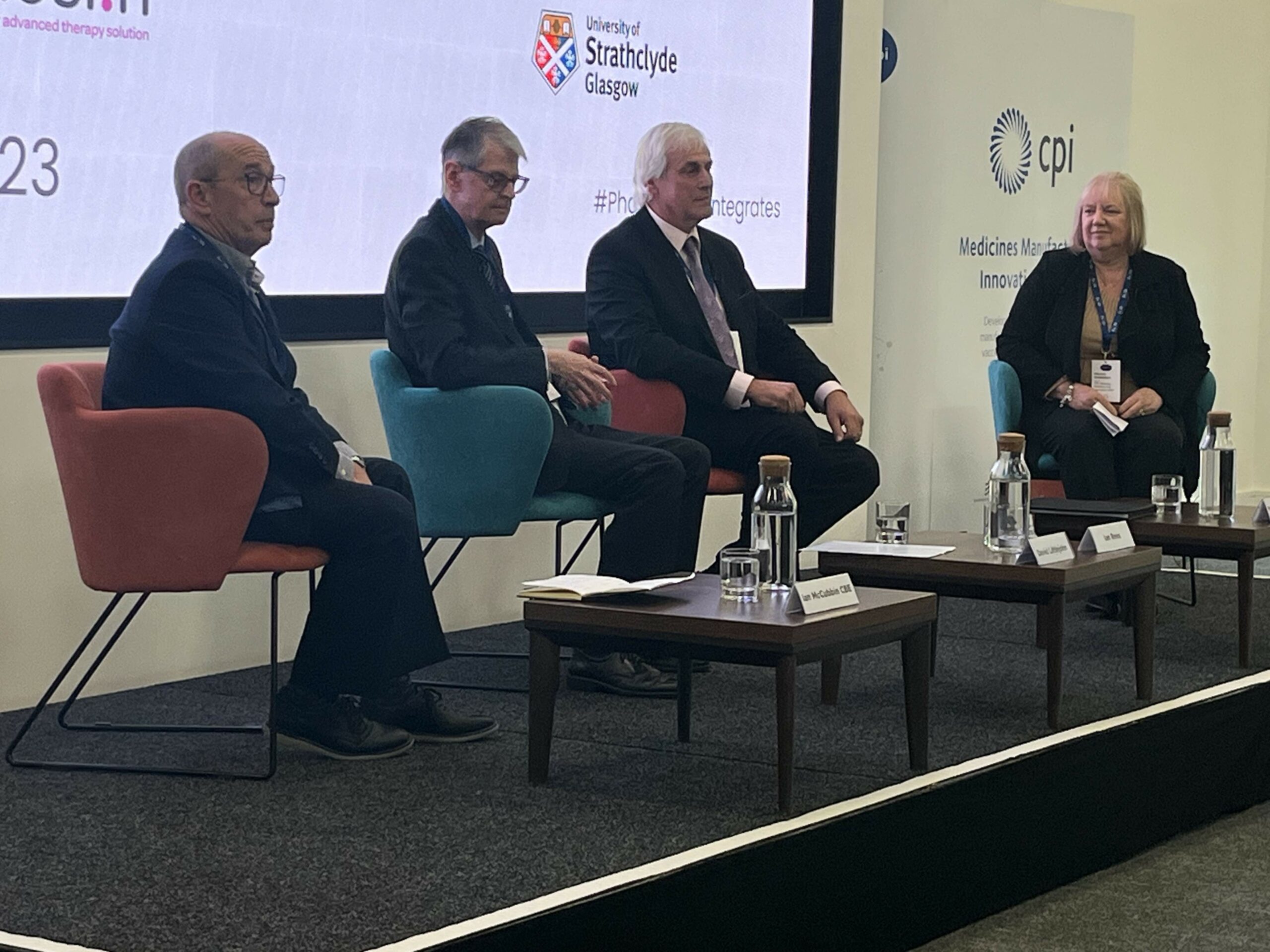
Speakers include:
Ian McCubbin | Chair | RoslinCT | Chair | Cell and Gene Therapy Catapult
David Littlejohn | Special Advisor to the Principal | University of Strathclyde
Ian Rees | Regulatory Affairs Consultant | DI REES Ltd
Interviewed by:
Maureen Wedderburn | Non Executive Chair, Medicines Manufacturing Innovation Centre | CPI
Panel Discussion Tracks:
Therapies, Digital & Data, Manufacturing & Formulation
“It seems a much cooler way of doing medicine”
– Session 1 (Therapies Track), ‘Oligo-new-cleotides’
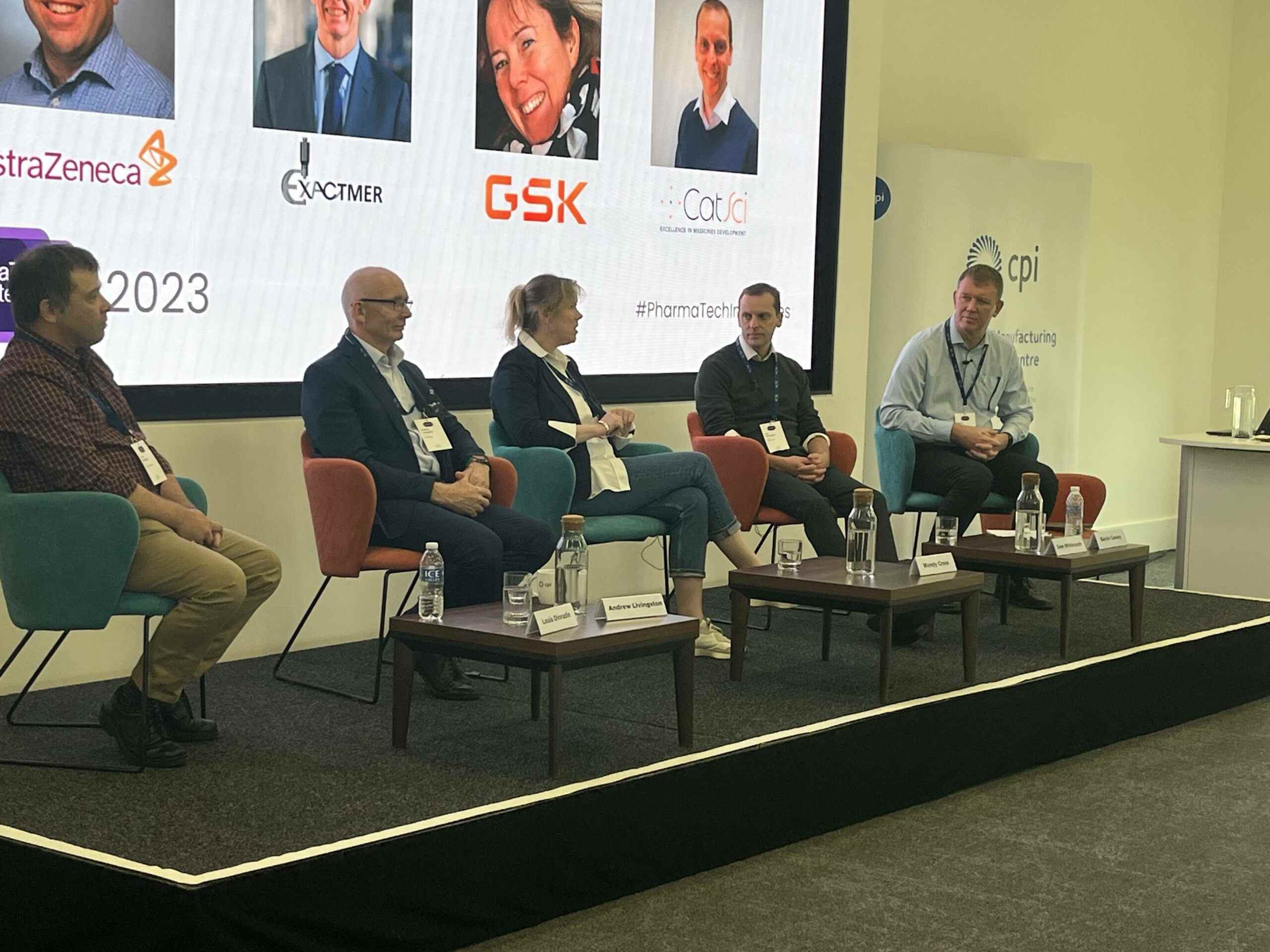
PANELLISTS
Louis Diorazio | Senior Principal Scientist, New Modalities | AstraZeneca
Andrew Livingston | Chief Executive Officer and Co-Founder | Exactmer
Wendy Cross | CMC Matrix Leader | GSK
Sam Whitmarsh | Director of Analytical Science and Digital Transformation | CatSci Ltd
FACILITATED BY
Barrie Cassey | Pharmaceutical and Biotechnology Technical Expert and Leader | CPI
“The oligonucleotide therapeutic market is likely to grow to 6.5 billion by 2030,” said Barrie Cassey, leading a discussion on the fast-moving field of oligonucleotides.
“If you were going to choose an ideal medicine, you’d choose something extremely targeted, that works at low doses, with extremely low side effects – oligos fit into this category,” said Sam Whitmarsh, explaining the excitement around this area. Wendy Cross continued the sense of excitement: “we’re standing on the cusp of something. At the start they were treating very sick patients, rare disease, small patient populations, but we’re moving to the mainstream now. The excitement is around getting this modality to as broad a patient population as possible.”
Despite the excitement, barriers remain, including scale up, costs, skills gaps, and the supply chain. “There’s a geopolitical element to the supply chain which can be challenging. But if we try to do it a different way with a different supply chain we hit regulatory challenges,” explained Andrew Livingston.
Despite challenges, panellists agreed that the unprecedented levels of collaboration in this area show great promise as they shared their hopes for the future of oligonucleotide manufacturing. “I think we’ll end up with a toolbox. I think we’ll see a greater diversity of approaches and a greater range of CMOs involved,” said Louis Diorazio.
“It’s about how and where it’s applied rather than the technology itself”
– Session 1 (Digital & Data Track), ‘Digital integration and differentiation – you do the maths!’
Chris Courtney led a discussion on the opportunities and barriers to building an integrated digital infrastructure. “It’s about saving lives, but doing it in a compliant way, a performant way, a sustainable way, and a financially viable way,” said Jorge Costa, commenting on the advantages technology can bring to pharmaceutical manufacturing, compliance, and quality.
Steven Kenny and Iain Crosley mentioned the advantages technology can bring to workers. “If we get technology right, workers will say ‘you’ve made my job significantly easier, I can’t possibly get it wrong any more,’” said Steven. “It’s about getting people to do the best things they can do by automating the tasks they find boring and repetitive,” agreed Ian.
Discussing barriers, panellists spoke of sustainability and cyber security.
“Chat GPT search uses 7x the energy of Google search. It’s about choosing the appropriate applications to use these high energy technologies,” explained John Mack. Ben Caley presented overcoming cyber-security challenges as an opportunity: “if you can be the company that’s building secure systems, you’ve got a real differentiator to set you apart from other companies. Be proactive.”
Ending the session, each panellists shared the one trend that most excites them, covering AI, horizontal integration, increased processing power, and a reduction in the barriers to adopting new technology:
“you no longer need to build a big data centre with servers and a complex infrastructure. You just need an internet connection and someone who can play with computers,” said Steven.
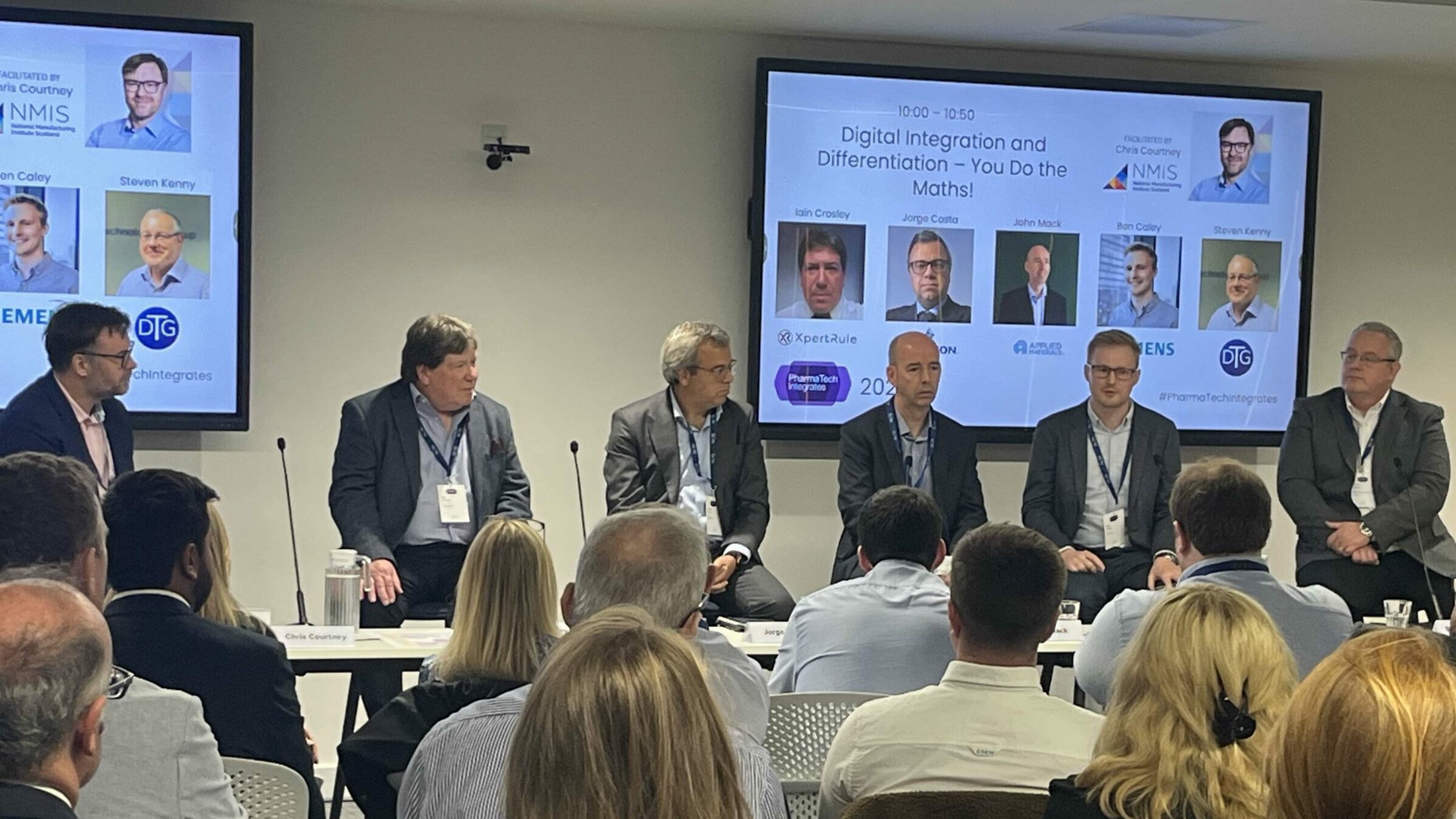
FACILITATED BY
Chris Courtney | Chief Executive Officer | National Manufacturing Institute Scotland
PANELLISTS
Iain Crosley | Director of Intelligent Manufacturing | XpertRule
Jorge Costa | Life Sciences Industry Consultant | Emerson
John Mack | Head of Perceptive APC Product Unit | Applied Materials Pharma Group
Ben Caley | Product Manager, Digital Industries’ Connectivity and Cyber Security | Siemens
Steven Kenny | Chief Technology Officer | DTG
“Standards will always lag because of the speed of innovation. But we need mechanisms to let them catch up”
– Session 2 (Digital & Data Track), ‘Standardly Unstandardised’
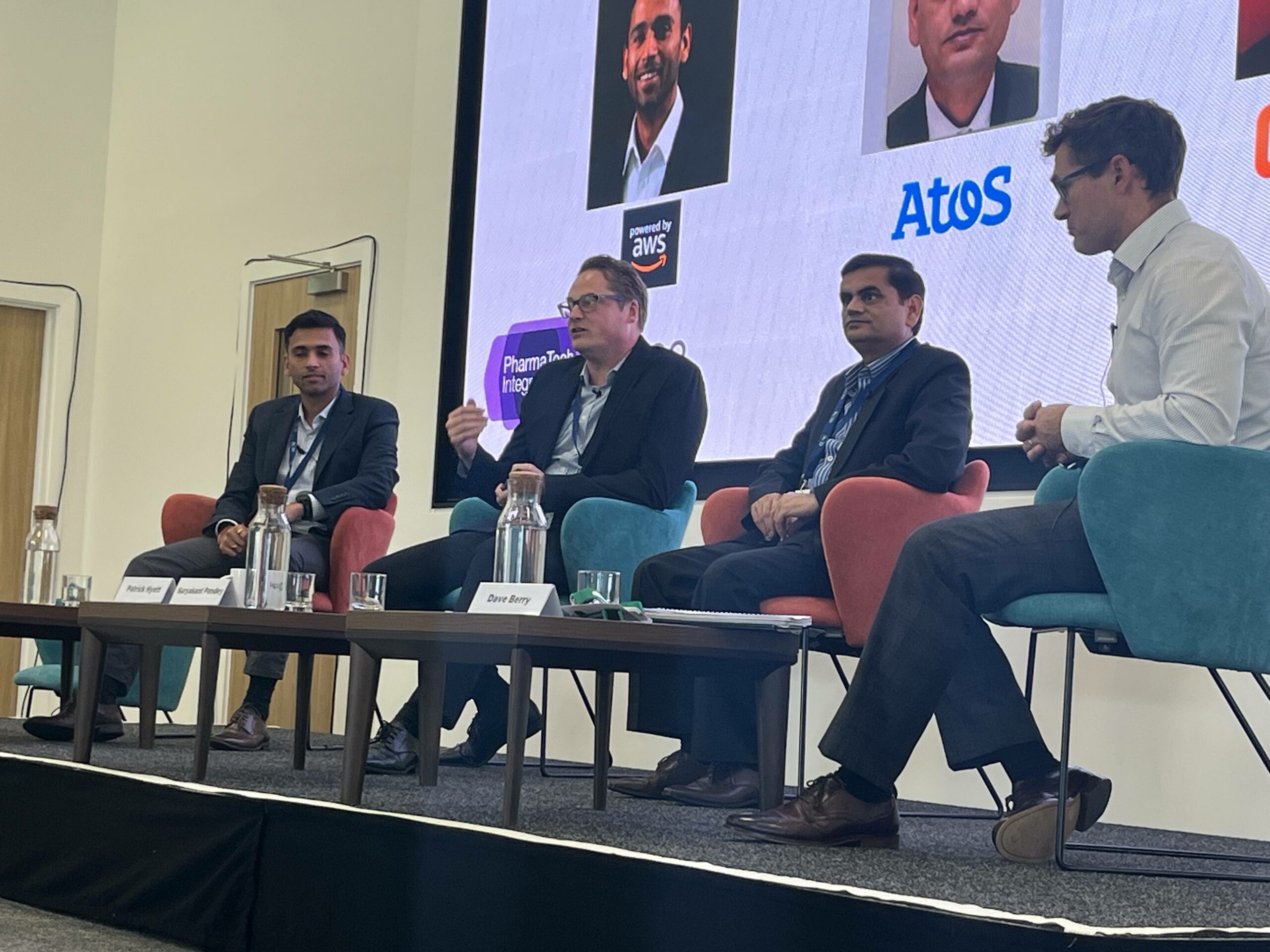
PANELLISTS
Nipun Sibal | Global Sales Pharma Manufacturing Lead | Amazon Web Services
Patrick Hyett | Pharma Supply Chain Tech Digital Innovation Lead | GSK
Suryakant Pandey | Enterprise Architect | Atos
FACILITATED BY
Dave Berry | Grand Challenge Lead, Medicines Manufacturing Innovation Centre | CPI
“We don’t talk about standards enough,” began Dave Berry, opening a discussion on the importance of standards in medicines manufacturing.
“In pharmaceutical manufacturing, standards are about a unified way of solving a problem where everyone’s working in the same direction but has flexibility to innovate,” said Nipun Sibal.
“Standards are important for any organisation,” agreed Suryakant Pandey, “if we haven’t implemented standards, then new technologies become much more difficult to integrate.”
Despite the importance of standards, panellists agreed that the industry still has a way to go.
“As an industry, the focus shouldn’t be on creating new standards, but on the adoption of common standards into everything we do,” said Patrick Hyett.
“Technology’s moving so quickly that standards aren’t a one-and-done deal, they’re something we have to invest in continually to exploit the best technologies.”
Looking to the future, panellists highlighted the importance of collaboration: “we’re all facing the same challenges with data. The key is collaboration. How does our industry start working together?”
“The ability to harness technology to give you agility needs people to think more intensely”
– Session 2 (Manufacture & Formulation Track), ‘This is intense’
“How do we use process intensification as a means to achieve targets?” asked Mark Talford, leading a discussion of the strengths, weaknesses, opportunities, and threats of intensification. Commenting on the current state of process intensification, Chris Van Der Walle compared the massive progress in intensification in the biologics sector with the less intensified state of cell and gene therapy, illustrating the varying states of progress across the industry.
The panel debated the factors needed to drive intensification, commenting on outcome-led thinking. “To make a business case for process intensification, we need to start with the business process that will be optimised rather than a new technology that can be applied to a process,” said Jon-Paul Sherlock. “You have to look at the whole process,” agreed Gareth Jenkins, “start out by asking what’s the fastest way to develop a drug – that’s how you halve development times.”
Other key enablers mentioned were integration and culture. “It’s not sufficient to just have a clever widget, you need to integrate the technology with data and you need to get the people on board,” said Dai Hayward MBE. “You need a cultural change in an organisation to successfully adopt a new technology,” said Rolf Hemminga, emphasising the importance of keeping people in mind.
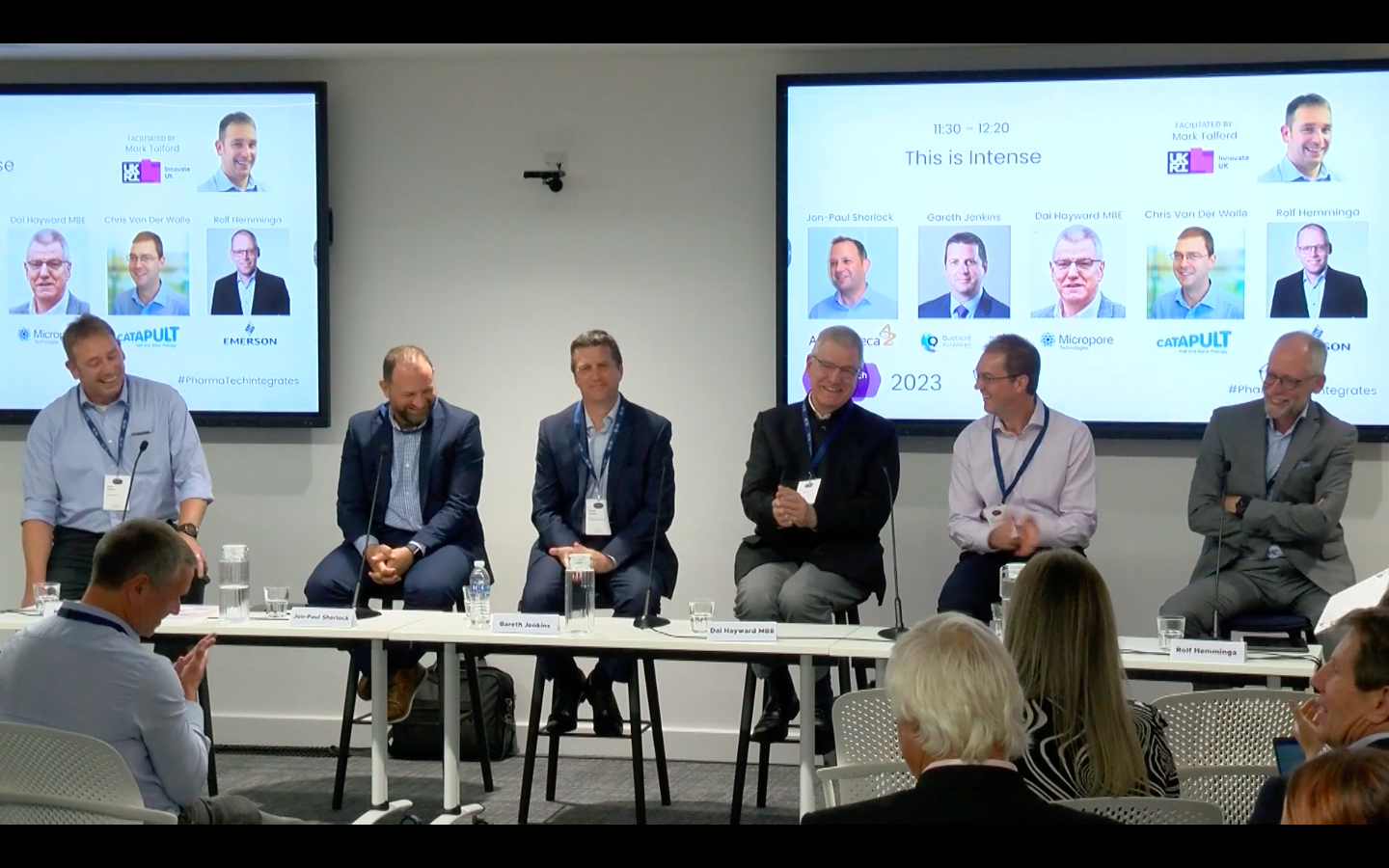
FACILITATED BY
Mark Talford | Deputy Challenge Director – Medicines Manufacturing Challenge | Innovate UK
PANELLISTS
Jon-Paul Sherlock | Head of Innovative Manufacturing Technology | AstraZeneca
Gareth Jenkins | Vice President, Science and Technology | Quotient Sciences
Dai Hayward MBE | Chief Executive Officer | Micropore
Chris Van Der Walle | Edinburgh Centre Director | Cell & Gene Therapy Catapult
Rolf Hemminga | Vice President Global Sales & Marketing Life Sciences | Emerson
“These challenges are too big to be solved by any one of us – what can we do as a community to drive progress?”
– Session 3 (Presentation): ‘Towards digital transformation of Chemistry, Manufacturing and Controls (CMC): Academic and Industry Perspectives’
Combining perspectives from industry and academia, Ivan Marziano and Alastair Florence explained their first-hand experiences in the digital transformation of Chemistry, Manufacturing and Controls.
Ivan commented on how the quest for sustainability, resilience, and human centricity is driving change in pharmaceutical manufacturing. He outlined the five key components of the digital domino race: “data sources need to be standardised, we need to store data so it’s accessible, we need to assess the level of data curation needed, we need to visualise relationships between the data, and we need to address the data queries of how we use it to develop and validate models.” Through case studies of effective data structuring and collaboration, Ivan showed how digital transformation allows us to go from product to process more efficiently.
Alastair presented the progress at CMAC, a medicines manufacturing research centre with a focus on delivering and translating research to industry partners: “we look at the entire value stream, from molecular materials through to bulk products, and focus on maximising performance and stability throughout the supply chain.”
He outlined CMAC’s integrated digital toolbox of technologies, capabilities, and ways of workings, which allow industry to traverse the stages of CMC with greater support from advanced technology predictive tools. Alastair highlighted the importance of integration and diversity: “we have a diversity of genders, cultural backgrounds, and scientific disciplines to give us a great team that’s open to collaboration.”
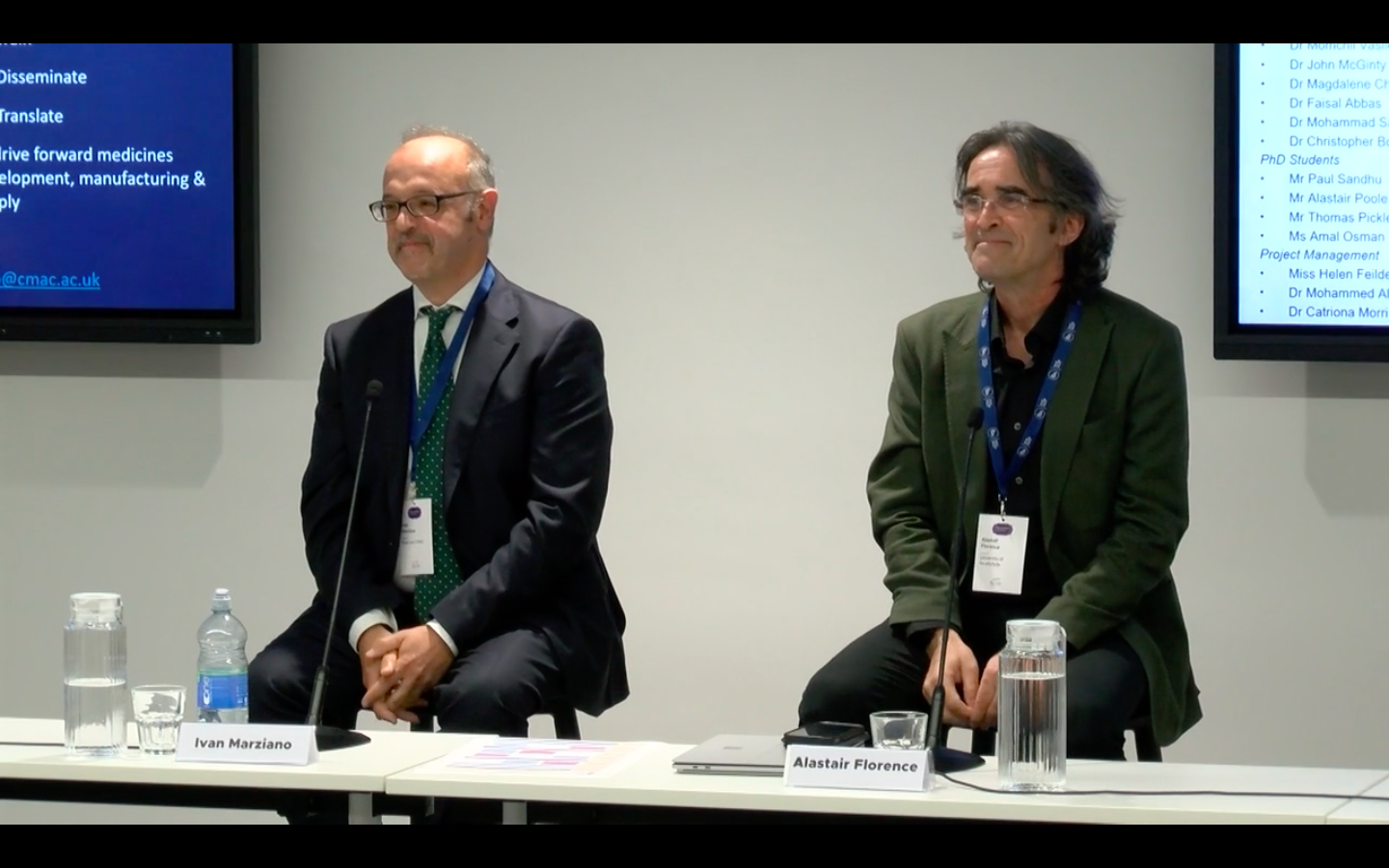
PANELLISTS
Ivan Marziano | Industry Board Chair for CMAC | Research Fellow for Pfizer
Alastair Florence | Director, Continuous Manufacturing and Advanced Crystallisation (CMAC) Research Hub | University of Strathclyde
“There’s no silver bullet to achieve Net Zero, there are only intelligent actions and practices”
– Session 3 (Manufacture & Formulation Track): ‘Manufacturing as a key to achieving Net Zero’
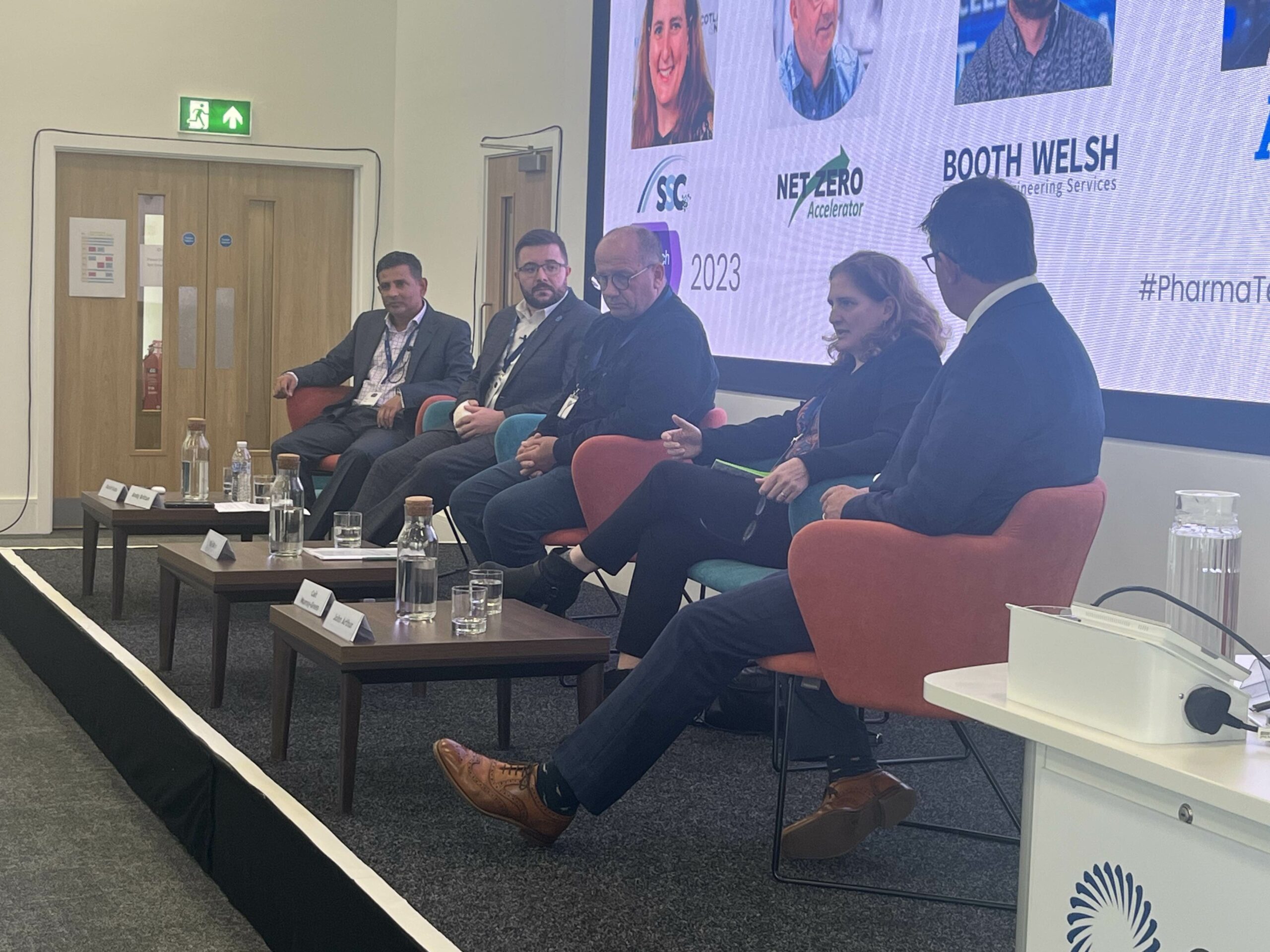
PANELLISTS
Manish Gupta | Lead Decarbonization Architect | Atos
Andy Brittan | Head of Technology Development & Digitalisation | Booth Welsh
Ray Black | Interim CEO | Net Zero Nation
Cait Murray-Green | Chief Executive Officer | Strategic Scientific Consulting
FACILITATED BY
John Arthur | Director, Medicines Manufacturing Innovation Centre | CPI
With a significant proportion of emissions associated with the design of medicines and processes, John Arthur asked how manufacturing technologies can help to deliver a sustainable future. Inspired by the facility tours, Manish Gupta commented on how CPI’s Medicines Manufacturing Innovation Centre demonstrates the sustainability commitments of the sector: “there are solar panels contributing towards 5% of their energy needs, there are heat pumps, there’s an onsite water treatment plant.”
Sharing an engineering perspective, Andy Brittan stated that “there’s no silver bullet to achieve Net Zero; there are only intelligent actions and practices.” He outlined how Booth Welsh’s Energy Monitoring Dashboard has allowed them to access the data necessary to improve sustainability: “diligently measuring, visualising, and analysing energy consumption data allowed us to achieved savings of about 20%.”
“If companies are really getting on with Net Zero, they need to take the foot off the profitability pedal,” said Cait Murray-Green. “What would your company do differently if you had a target of only 10% of last year’s profits?” Cait asked, imagining a situation where companies had 90% of their earnings to invest in Net Zero transitions.
“We may reach a situation where this is mandated,” responded Ray Black.
“We need to make fast progress on science-based Net Zero targets as opposed to monetary performance targets.”
“Data is critical for supply chains”
– Session 4 (Digital & Data Track), ‘Supply chain reaction’
“Where is the digital approach taking the supply chain, how is the supply chain reacting, and how can we drive connectivity?” asked Scott Lawson, leading the ‘Supply Chain Reaction’ session.
“Data is at the heart of better connectivity in supply chains,” said Rob Innes, praising the increased awareness of the value of data over recent years. Rebecca Street agreed: “data is now recognised as an asset that’s worth investing in. Data is as much a part of our product as the physical product itself.”
Turning to the integration of data into supply chains, Dave Berry emphasised the importance of standards and structure: “if we don’t bite the bullet and think about the high-level structure of data at the start, it’s always going to be a mushy mess.”
Kevin Wright agreed, commenting on the importance of ensuring you have the right metrics in place from step-one: “you get what you’ve designed for,” he said.
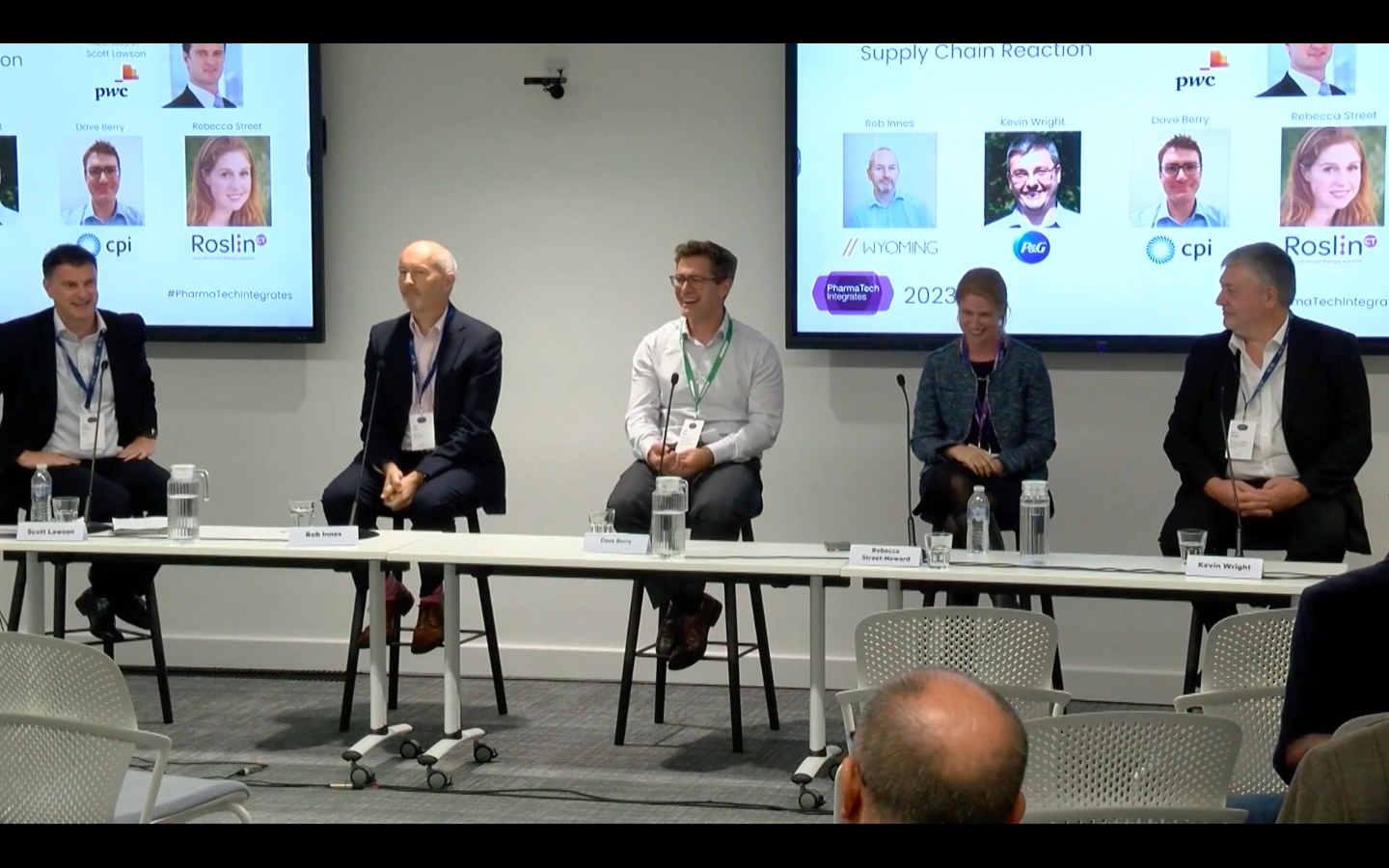
FACILITATED BY
Scott Lawson | Partner | PwC
PANELLISTS
Rob Innes | Co-founder and Head of Life Sciences | Wyoming Interactive
Dave Berry | Grand Challenge Lead, Medicines Manufacturing Innovation Centre | CPI
Rebecca Street | Head of Digital Operations | RoslinCT
Kevin Wright | Technical Director, Corporate QA- Industrial Microbiology | Procter & Gamble
“Having quality from the start gives you the ability to have the agility”
– Session 4 (Manufacture & Formulation Track), ‘Uncertainty is Certain’
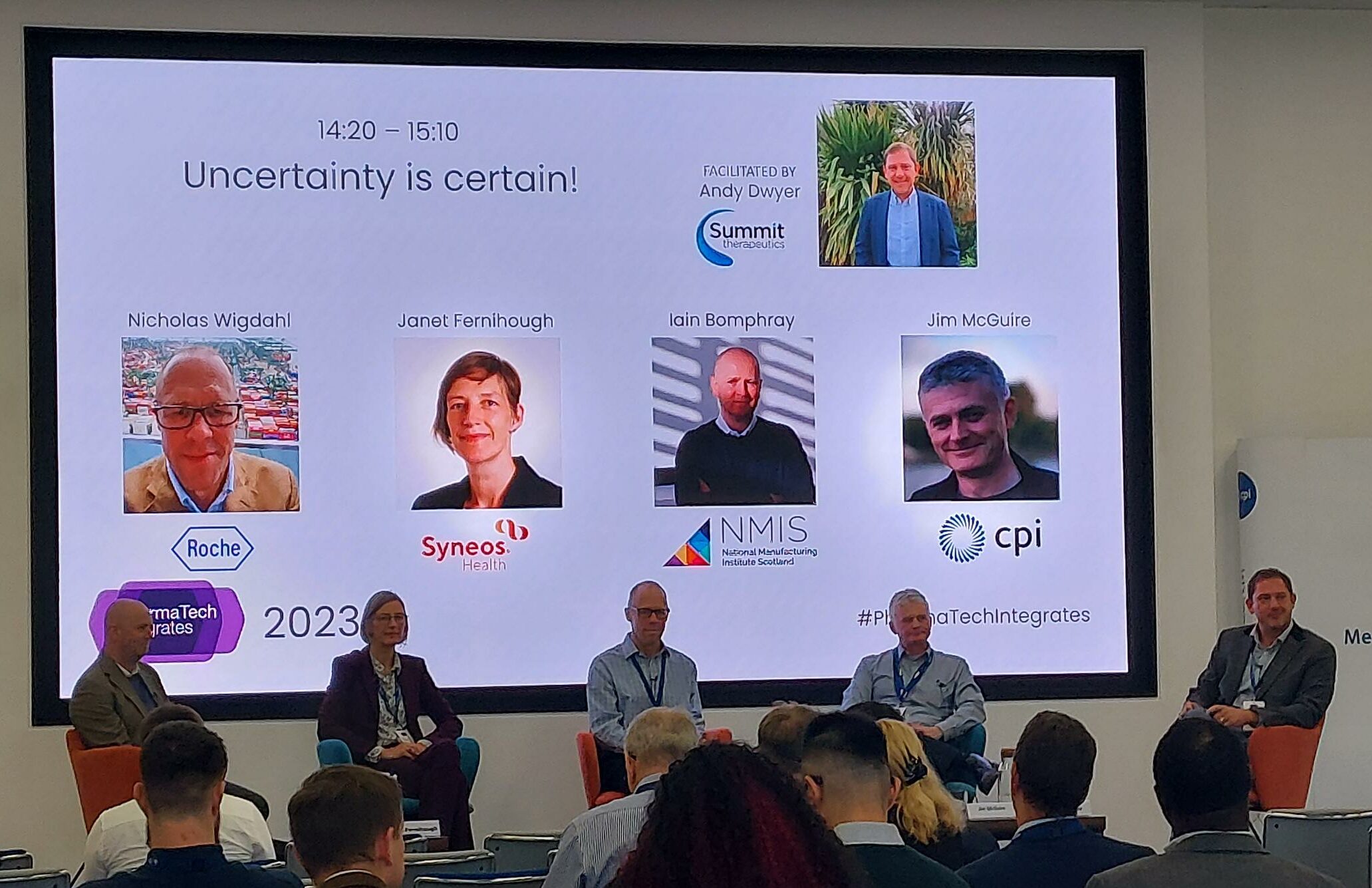
PANELLISTS
Nicholas Wigdahl | Established Product Strategy Group Lead | Roche Pharma Technical Services
Janet Fernihough | Director, R&D Consulting | Syneos Health
Iain Bomphray | Director of the Lightweight Manufacturing Centre | National Manufacturing Institute Scotland
Jim McGuire | Grand Challenge Lead | Medicines Manufacturing Innovation Centre, CPI
FACILITATED BY
Andy Dwyer | Senior VP of CMC and Supply Chain | Summit Therapeutics
Leading a session on the agility needed to deal with uncertainty, Andy Dwyer outlined how factors such as unpredictable demand, manufacturing equipment issues, or quality issues in the marketplace, create situations you didn’t plan for.
“There’s political uncertainty, supply chain uncertainty, increased natural disasters, a rising energy crisis,” said Nick Wigdahl, outlining current challenges. Panellists commented that we can deal with this uncertainty through earlier collaboration with regulators, distributed supply chains, and industry standards.
Looking to strategies to increase agility, Jim McGuire explained the need for just-in-time manufacturing: “no one wants their clinical trials to be delayed by a shortage of the drug you’re testing, so pharma companies tend to make a huge excess of stock. This isn’t sustainable, it’s hugely wasteful, and it’s not possible for smaller spin-outs that don’t have deep pockets, but it’s the only option without a system for just-in-time manufacturing.”
Janet Fernihough spoke of the increased agility that comes from using digital twins to plan and predict: “you can model all sorts of ‘what if’ scenarios in silico, giving you the power to be predictive and to make mistakes without having an impact in real life.”
All panellists agreed that ‘people’ are key to creating agile systems, and Iain Bomphray spoke of the importance of having the correct culture. “In my experience, no-blame cultures really unburden individuals to take more risks and push the boundaries a little further,” he shared.
Fireside Chat
Fireside Chat 2: Transforming Drug Development
– Exploring Breakthrough Digital Technologies and System Thinking Approaches to Revolutionise Manufacturing and Supply
“I hope digitalisation looks like the norm”
– Fireside chat 2
“There’s a wealth of interesting new technologies, but I’m yet to see them all joined together to produce an end-to-end solution,” said Dave Tudor, finishing the day with a second fireside chat focused on how digital innovation can transform drug development.
“The momentum is there in the pharma sector to talk technology and make a change, but we’re not there with digital transformation yet,” said Rebecca Vangenechten. “67% of all digitalisation projects fail in some way. This doesn’t make us happy as technology providers. We need to make sure our technology is sufficiently interoperable, flexible, modular, and open. But we also need to address the human aspect: are we demystifying and democratising technology enough?”
Panellists noted that a key factor to overcoming this challenge and achieving successful digital integration is collaboration. “We’re at the boundary of our own knowledge and capabilities so collaboration is inherently important,” said Paul Hardy. Chris Kopinski added his experience of collaboration from working with 19 of the top 20 pharmaceutical companies at Amazon Web Services: “there’s complexity in our industry, but we need to come together and decide how we want to move forward as an industry, and work together as an ecosystem to make change happen.”
Speakers shared their hopes for digital transformation in the next 10-20 years, discussing vertical and horizontal integration and the predictive power that comes from combining electronic healthcare data with data from smart devices and wearables. “I hope digitalisation looks like the norm,” said Chris, “we’ll no longer talk about digitalisation, it will just be part of the way we work.”
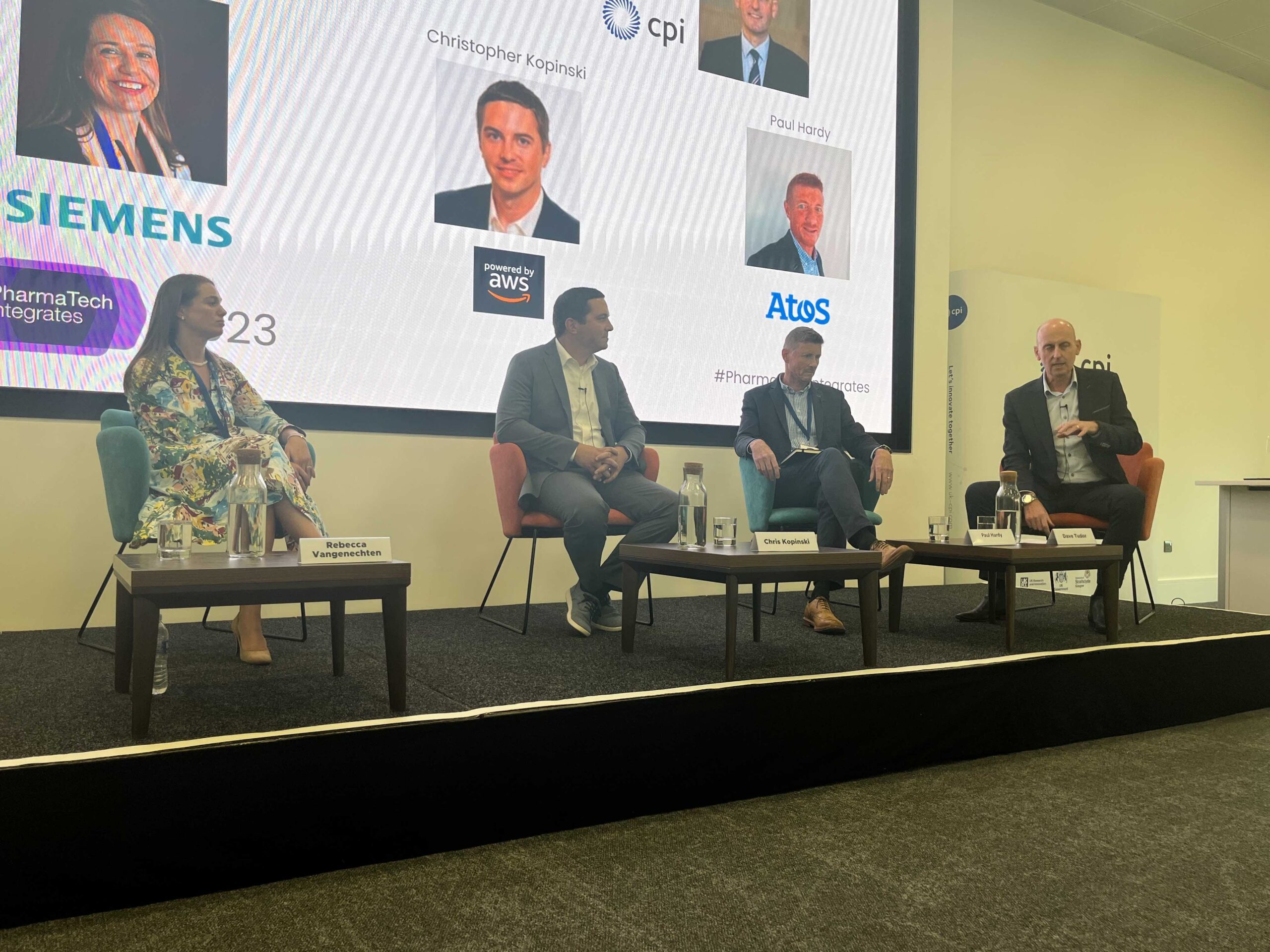
Speakers include:
Rebecca Vangenechten | Head Vertical Pharma Segment | Siemens
Chris Kopinski | Head of Strategy & Business Development HCLS/Manufacturing Industry Products | Amazon Web Services (AWS)
Paul Hardy | Client Executive Partner | Atos
Interviewed by:
Dave Tudor | Managing Director, Medicines Manufacturing Innovation Centre, Biologics & Quality | CPI
3 years of PharmaTech Integrates
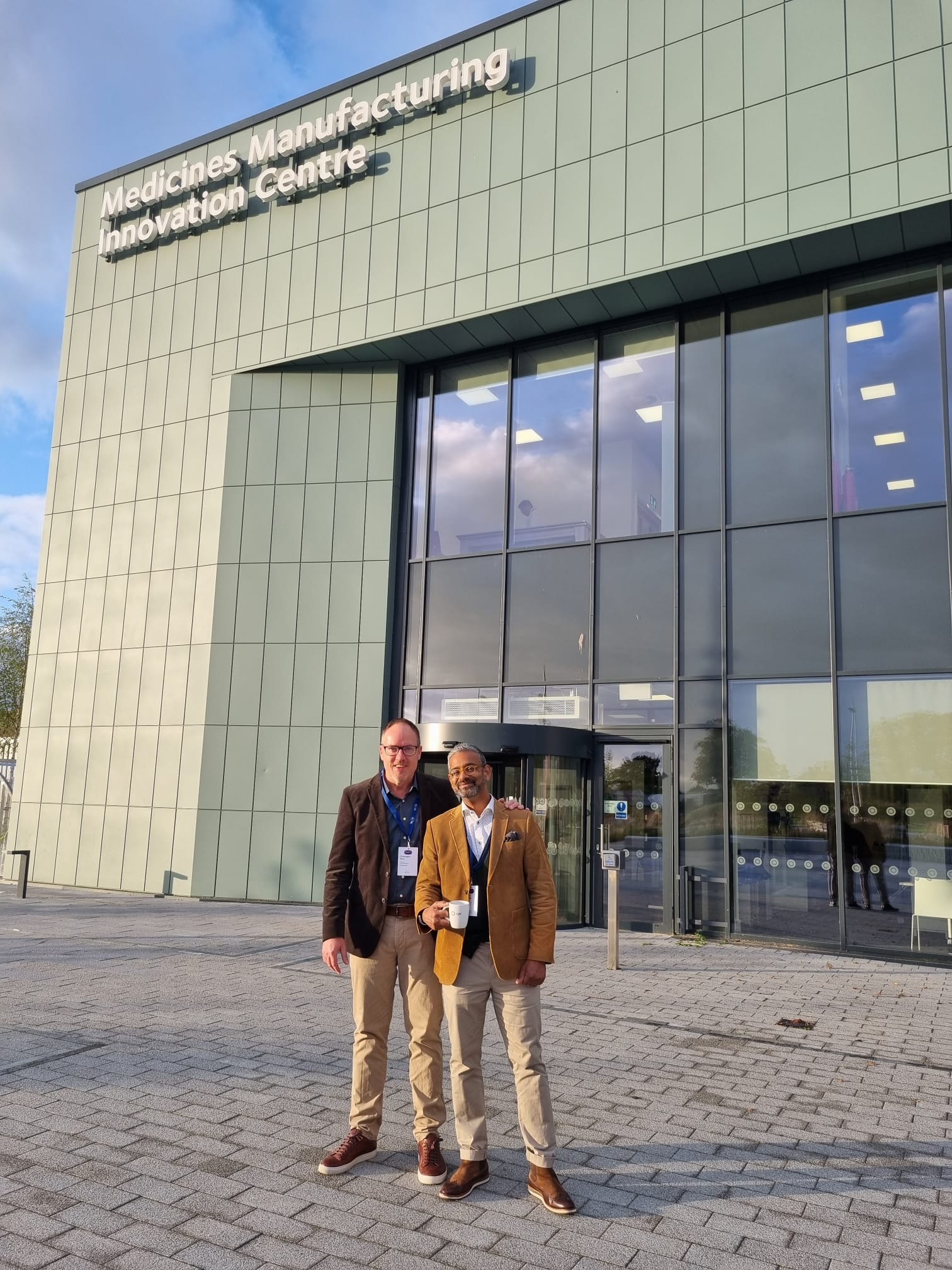
“In its third year running, we’re so glad to see the continued and growing interest in PharmaTech Integrates,” said Christopher Watt, Executive Director, Life Science Integrates, “it’s been great to hold the event across the two fantastic venues of CPI’s Medicines Manufacturing Innovation Centre and The National Manufacturing Institute Scotland, and we’d like to say a huge thank you to everyone who’s made this possible.”
“Thank you to CPI’s Medicines Manufacturing Innovation Centre for your continued support as official event partner, and thank you to all the sponsors, speakers and attendees who’ve joined us here in Glasgow or online,” added Life Science Integrates Executive Director Samuel Thangiah.
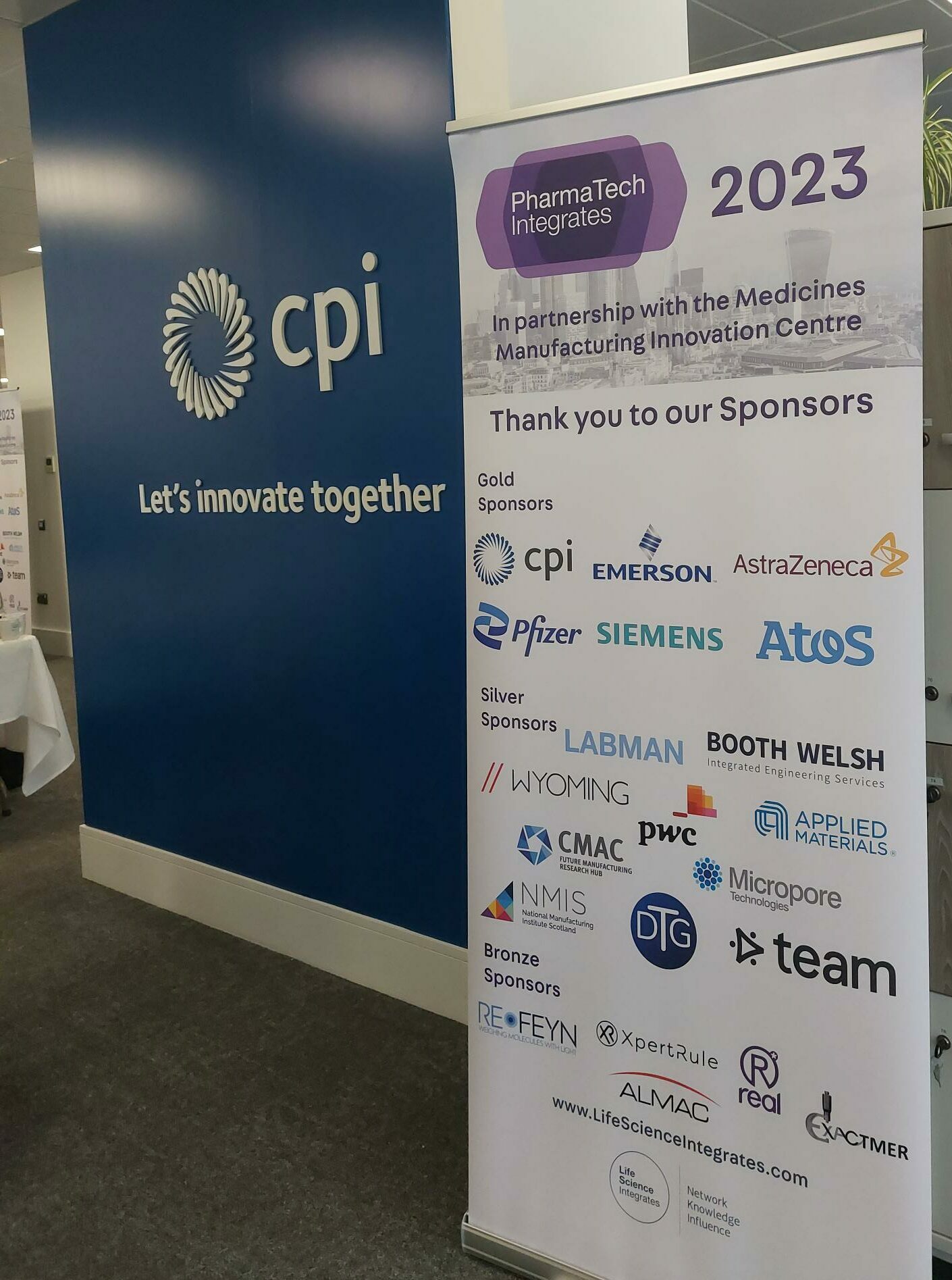
Christopher Watt and Samuel Thangiah, Life Science Integrates
A big thanks to our event partners and venue hosts; CPI and NMIS; alongside a record number of valued sponsors.
